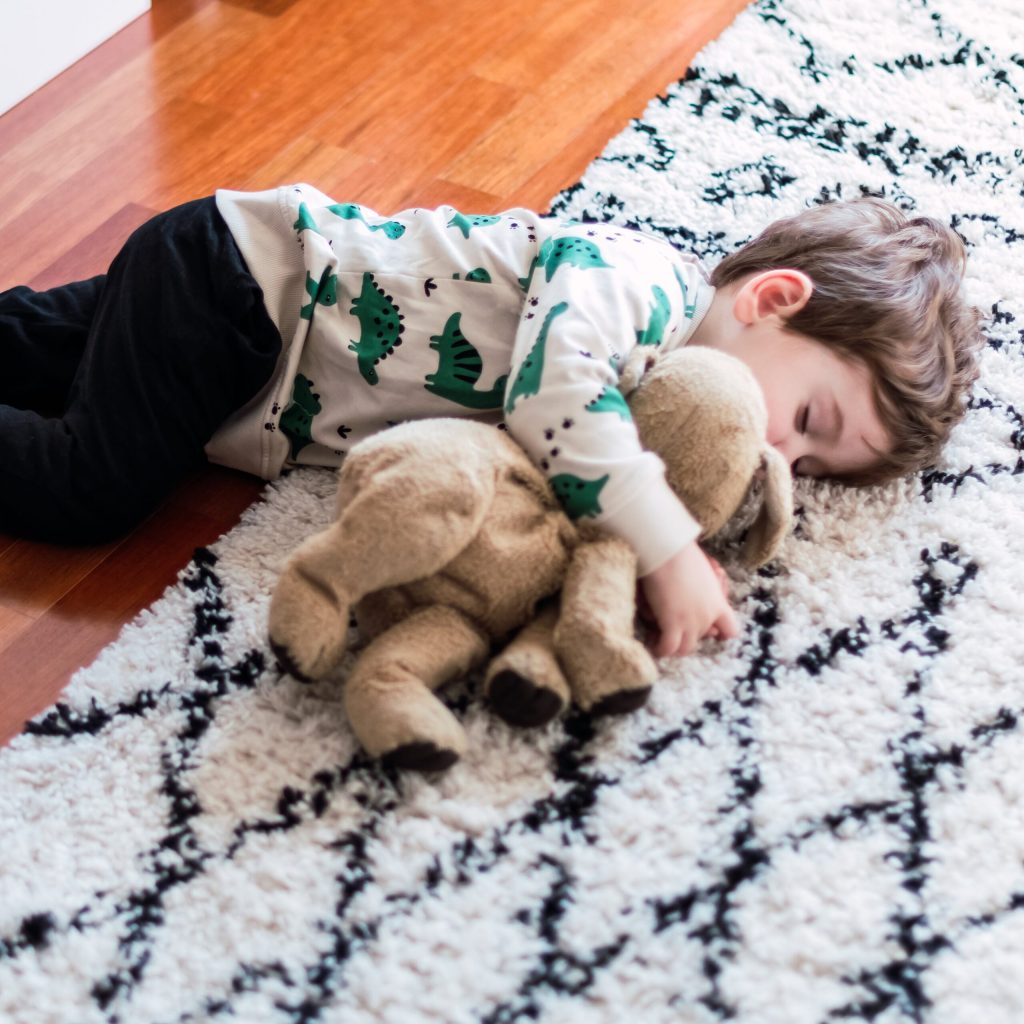“Knock, knock, knock” my almost 2-year-old called from his bedroom. Going to check, I found one of his little hands was knocking loudly, while the other was reaching out from underneath the door. It was his latest tactic to get me to let him out of his room, where he spent the last hour drifting between asleep and awake – on the floor.
For weeks, Liam had been fighting naps, getting out of his toddler bed repeatedly, and falling asleep on the cold carpet. I’d tried putting him back to bed over and over. I’d tried letting him cry it out. I’d tried rocking him to sleep. Nothing made a difference in my stubborn second-born’s nap habits. (Luckily, he always slept just fine at night, but his naptime protests were really getting frustrating.)
Talking to my friends, I learned that my son’s behavior is actually a common problem. Whether it’s due to teething, newfound independence, schedule changes, a 2-year-old sleep regression, or just being overtired, toddlers have a lot going on, and it’s normal for them to fight sleep sometimes. Even when their eyelids are heavy with fatigue, the little ones will try to keep them open, not quite ready to drift off.
But finding your toddler stretched out on the floor when their comfy mattress is just steps away can be especially frustrating and concerning. So, to help discover why toddlers sometimes prefer sleeping on the floor, POPSUGAR talked to a psychologist and a certified pediatric sleep consultant to find out more.
Why Is My Toddler Sleeping on the Floor?
So many of toddlers’ strange habits can be chalked up to the developmental stage they’re in, and their affinity for sleeping on the floor is one of them. “When toddlers are first learning to self-soothe, it can take time for them to develop these skills without parent assistance,” Stephanie Lee, PsyD at the Child Mind Institute, tells POPSUGAR. “If toddlers are refusing naps and/or engaging in escalated behavior prior to the nap, it might take them even longer to self-soothe.”
In other words, your little one is learning how to self-soothe themselves to sleep. It’s a tough skill to master, and along the way they may be trying a lot of different things – including a little acting out – due to the frustration and anxiety they feel.
There may be other factors that contribute to toddlers wanting to sleep on the floor or fighting sleep on the floor. “Toddlers may sleep on the floor if they’ve been moved out of a crib too soon (i.e., before 3 years old), and if they’re not clear about their parents’ expectations, or are not confident in their ability to fall asleep independently,” said Sierra Dante, certified pediatric sleep consultant at SweetSleepConsulting.com.
They may also have some FOMO if they suspect everyone else in the family is going to hang out and have fun while they’re dozing; or they may be getting ready to dial down their naptimes, and are sleeping on the floor as a way to indicate that they’re not all that sleepy.
“If a child is struggling with naps and bedtime, timing can also be an issue,” Dante says. “Children who sleep 11 to 12 hours at night (which is standard for babies, toddlers, and preschoolers) are ready to stop napping between 2.5 and 3.5 years of age. If a child is still napping or even getting too much sleep at naptime, this can cause bedtime disruptions.”
What Can I Do to Help My Toddler Stop Sleeping on the Floor?
Watching your child struggle with anything is heartbreaking as a parent. Especially when it’s something as important as sleep. So, how can you get them to sleep in their beds instead of the floor?
“There are a lot of different ways to approach this, and it really depends on your family and bedtime routine,” Dr. Lee says. “It may be helpful to try using rewards and/or requiring your child to sleep in their bed by doing your best to be consistent in returning them to their bed. I know it’s tough, but often if you persist through a couple rough nights, your efforts are rewarded.”
Another tip is to consider tweaking your toddler’s sleep routines to test whether they’re getting too much sleep. “Consider tracking when your child actually falls asleep at night and trying to set bedtime a little after this time in order to use their natural sleep cycle to your advantage,” Dr. Lee says. “After a few nights of delayed bedtime success, you can try and start modifying bedtime back to an ideal time by 5- to 15-minute increments and while monitoring wake times.”
Having a consistent bedtime and naptime routine in general can also help toddlers who are sleeping on the floor because they just don’t want to go to sleep and miss out on any fun, or because they’re having a hard time learning to self-soothe. “Using a consistent bedtime/naptime routine can help a child with predictability and decrease some of this anxiety,” Dr. Lee says.
If you want to read more about this complicated (and frustrating!) topic, Dr. Lee highly recommends “Good Night, Sweet Dreams, I Love You: Now Get Into Bed and Go To Sleep” by Patrick Friman.
But the bottom line is, try to give toddlers sleeping on the floor grace, reinforce structure and routine – and make an extra cup of coffee.

